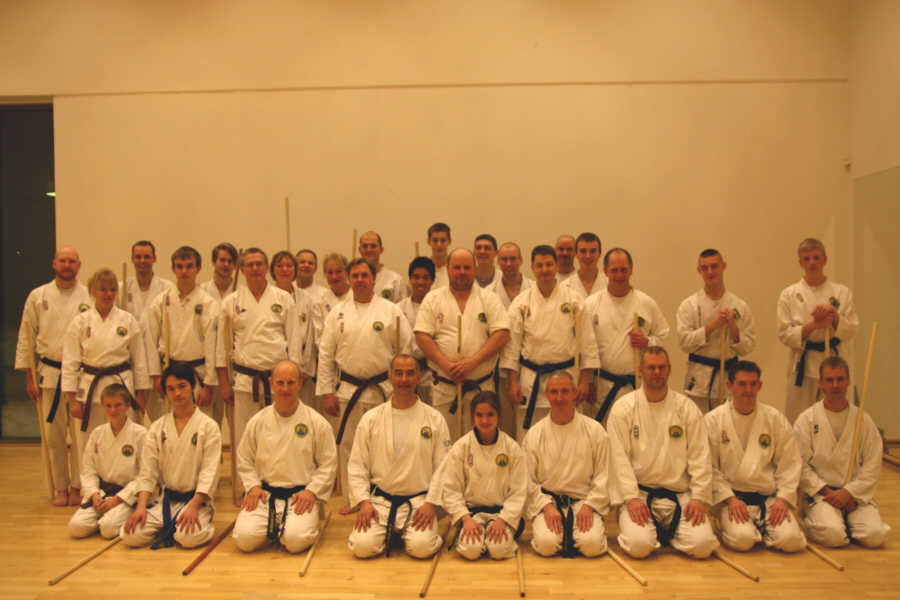By Martin E. Hansen, Member until 2018
I have gradually become an old fox (but still the youngest of the Chief Instructors) at Shindenkan and tried a lot over the years. But I can still be like a little kid looking forward to Christmas Eve, and this year's Jo-jutsu course was about to give me goosebumps with sheer excitement before it even started. A few years ago, when Shindenkan was called Jokokan in Denmark, and I was still a brown belt and on the verge of starting Jokokan Korsør, I was invited to a special training course in the spring and summer of 2002 by Kimu Sensei towards my Shoden graduation. Part of this special training also involved training with jo (you can read more about the special training course in articles that can be found in the archives here on the website). I remember that one of the first things I was told back then was that you should love your jo (not love with J). At the time, I didn't put much thought into those words, other than that I of course took it to heart. When I think about it today, and the content of the jo-jutsu course we just went through, I understand more what Kimu Sensei actually meant by "loving your jo".
Jo-jutsu course package 1 was planned to take place over 2 Fridays 14 days apart in November and December respectively. The invitation came as usual from Honbu-dojo with Kimu Sensei as sender and teacher. However, for resource and development reasons, it was only on this jo-jutsu course that Kimu Sensei would teach, as the course will in future be handled by Jens Kyoshi, who will hopefully soon enter the Menkyo step and is the only one apart from Kimu Sensei who can teach competency courses of that nature. The fact that it is a skills course also means that you must have participated and passed in order to pass a graduation to the degree where the course is required. So if all black and brown belts wanted to progress in the future, all they had to do was register for the course. The registration percentage was very high and basically those who could participate were also registered, which again testifies to the high interest there is in Shindenkan's courses and not just out of necessity.
The first day of the course traditionally offers a ryugi lesson before the practical ryuha, so approx. 46 expectant participants filled the small glass hall in Måløv hall, where Kimu Sensei had prepared a PowerPoint show. Through the next approx. hour and a half we were taken through the structure of courses in Shindenkan and the common thread naturally linked over to the ancient history of koryu bujutsu and when the various weapons such as katana, yari, bow and bo were introduced and used. It was very interesting to see how it slowly dawned on all participants, how diverse it is to train in Shindenkan and what skills you gain compared to other single-track martial arts systems, which are off the shelf in most places. In Shindenkan, 1000 years of history are really trained and it is documented all the way back to the first great masters and experiences from the battlefield. It is almost with awe that you think back on how many samurai were slaughtered in ancient Japan, so that we can today benefit from all the knowledge passed down unadulterated through generations. And it would also be a shame if it were to be lost.
After the theoretical part, it was time to swing the poles and in a changed state we all moved towards the glass hall. It was satisfied smiles that spread on the lips of all the participants when, after the warm-up, they grabbed the poles and had to start the practice itself. As a small hint, we had learned during the theoretical part that jo-jutsu is a "hub" course, i.e. a competence course that brings together the knowledge of all previous courses and makes use of this as a common thread that binds different pieces of knowledge together. So big aha experiences were planned, but perhaps also small "defeats" in the form of areas you may have neglected during your training, which would now be revealed. To begin with, the joy of recognition was greatest when the label was introduced and confusingly it looked like the label from the other weapons courses, albeit with more details and in 2 different versions depending on whether you have an offensive or defensive approach. The level had been raised slightly from the other courses as more emphasis was now also placed on tachi-ai (the teaching of connecting points physically and/or mentally). Without having to reveal all the content of the course, we now started to train the basic kamae, where you could sense that small light bulbs were lit above the heads of the participants "Ahaaa!" was thought about. But when we reached the base on foot, there was a little more thoughtfulness to trace.
After all, in addition to being a weapon, it is also a good tool for "revealing" how to move in the basic positions, i.e. whether you use your body correctly when moving back and forth in, for example, zenkutsu dachi. The jo actually becomes a pointer that reveals whether you e.g. moves from side to side and does not maintain the center and at the same time a good measure of whether you can also keep the center while doing cross tension, which is basic in all movement, but becomes more pronounced the better you become. Many, including myself, got a lot to think about here and it's great that Kimu Sensei says ”THANK YOU! because I have now found a work area where I can improve". This is important in order not to fall into the ditch with the "No hat" and belittle yourself for something you have neglected or not focused on, because we are all much better than we tell ourselves to be. Always approach a work area with a positive and constructive approach rather than a negative and destructive one. Time passed quickly with more walking basics and kumite training in the form of tsuki, which filled the heads of the participants, who gradually could feel that a jo of Japanese white or red oak is not the easiest thing in the world. Nicely and very naturally, the last point of the day was two ancient health exercises with jo, which simply means that you use the jo as a work tool in a stretching exercise that stimulates the body's wiring - the meridians, which we also know from the shiatsu course and acupuncture.
In the time between the course days, it was planned to train at home in the local schools, as part 2 of the course would be more intense and with many more techniques and principles, which turned out to be true. So there was training locally, where there was great agreement that so far it was a great course and it was nice that you could start to see a connection between the other courses and why they were built the way they were. But at the same time, there was also astonishment and humility about the course's ability to reveal personal areas of work.
Suddenly it was Friday 10 December and time for the jo-jutsu course part 2. When it is December there is also a risk of a bit of snow. But you have to say that this year a lot of snow has fallen, so this Friday the traffic was at a standstill, which other than me was also affected by and we had to wait nicely for the last ones to show up before the course could start, but we are good at Shindenkan and like to wait so that everyone has a chance. The next 3 hours passed very quickly as we were led from one technique to the next in a large number of different combinations both offensive and defensive techniques. Again, the plan was to either have an "aha" experience or an indication of a possible work area or both J When you start your karate training you are always told that all movements originate from the hip or the center of the body. This of course also applies to training.
In fact, it becomes really clear if you have understood what it means to start the movement from the hip when you have to train, for example, uchi and soto-uke with jo. The Jo must make a spiral-like circular movement during the performance. You can try to do this movement with the arms alone, but it will never be right, nor will it look right, if it is only the arms that perform the movement. The correct movement is the start of training what is called Haké (A form of power generation with the body alone that most closely resembles a salsa or belly dancer movement at speed J) It really requires loose hips, body control and imagination to perform it correctly. It has to be said that a real James Bond story was tied in the course at the Jo training, when Kimu Sensei told about how he and other grandmasters had broken jos and bokutos in the air just using power generation alone, which was nodded appreciatively in the assembly, but at the same time envy shone in the eyes of most, who could well see themselves breaking their jo in the air. Again, the course part was concluded with health exercises, where some new ones were added, but with the same purpose, to stretch and stimulate the meridians but combined with correct breathing.
In contrast to Kimu Sensei and his description of breaking the jo in the air, I can relate a, for some, funny little story from my own home training. While I was in the process of commenting on a document about the completed course, I also got hold of the jo and practiced some techniques while reading them through. My girlfriend was lying on the sofa watching TV while she wondered about me standing there alternately between the computer and with the "broom handle" in my hands. I had reached age-uke, which with Jo means that you tilt it up with the previously mentioned "hook" movement, with the aim of defending against a straight blow with Jo, for example. I have not yet fully analyzed what went wrong after that, but in any case I planted the jo in the shell of myself, as the initiating movement from the hip was stronger than the grip on the jo with my left hand. My girlfriend laughed as she said “what happened? I could hear it all the way over!” I cursed myself as I was sent for the count. I had hit myself with a kyusho in the left eyebrow and was unsure whether it was my skull or the jo that had acknowledged with a crunching sound during the contact. However, I could be happy that at least I had hit exactly in the center and didn't get a black eye afterwards. So a good piece of advice is – make sure you hold on to the jo the next time you train
To return to the statement from the beginning of this article, perhaps you have thought about what is meant by "you must love your jo"? It is actually quite simple. The jo helps you to express your true level and reflects your ability here and now – if you don't love your jo, you don't love yourself either. So in this happy Christmas season, it will be appropriate to stand in front of the mirror with your jo in hand (I said jo'en J) and look yourself in the eyes and say to yourself "I love myself for who I am" and when you're at it, tell those closest to you too.





